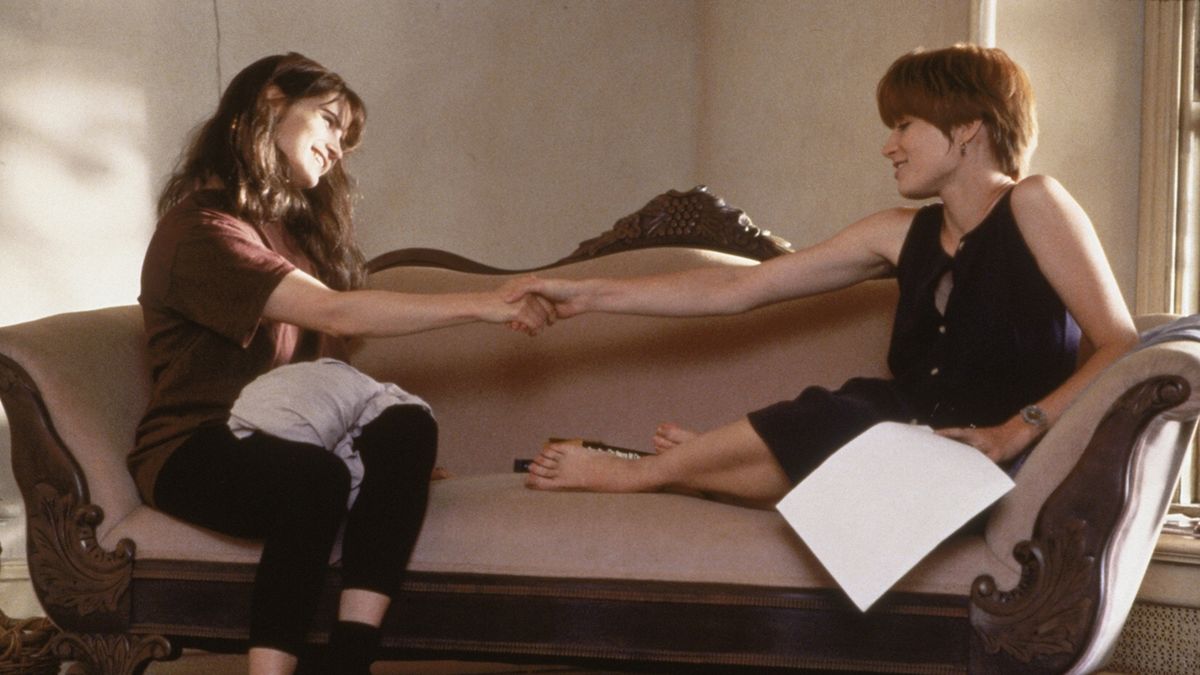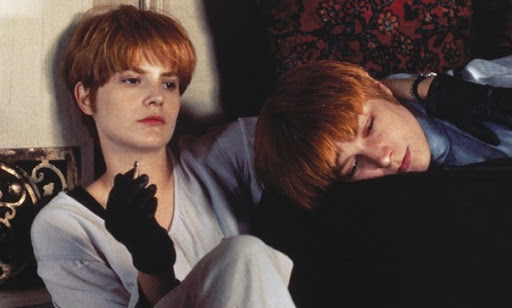a series by Christopher James looking at the 'Gay Best Friend' trope
 You wanna hear a story about how me and this bitch fell out? It’s kinda long, but it’s full of suspense.Gay Best Friends aren’t often paired with gay panic. Especially in movies made more than 10 years ago, we either were taught to laugh at queer characters, cry for them or fear them. Single White Female asked us to do two of the three. The 1992 thriller didn’t just settle for giving our jilted protagonist, Allie Jones (Bridget Fonda), a supportive gay best friend (Graham, played by Peter Friedman). They also paired her with a roommate nursing a lesbian crush on Allie and refining her murderous skills (Hedra Carlson, played by Jennifer Jason Leigh).
You wanna hear a story about how me and this bitch fell out? It’s kinda long, but it’s full of suspense.Gay Best Friends aren’t often paired with gay panic. Especially in movies made more than 10 years ago, we either were taught to laugh at queer characters, cry for them or fear them. Single White Female asked us to do two of the three. The 1992 thriller didn’t just settle for giving our jilted protagonist, Allie Jones (Bridget Fonda), a supportive gay best friend (Graham, played by Peter Friedman). They also paired her with a roommate nursing a lesbian crush on Allie and refining her murderous skills (Hedra Carlson, played by Jennifer Jason Leigh).
Broad doesn’t begin to describe the movie. While it swings for the fences with its queer characterizations, a large degree of camp shines through. This makes for a pleasurable “turn-your-brain-off” wild thrill ride...
Software designer Allie has just broken up with her cheating boyfriend, Sam (Steven Weber) and is in desperate need of a roommate for her lovely, rent-controlled Upper West Side apartment. After debriefing with her upstairs neighbor and gay best friend, Graham, Allie puts an ad in the paper. A slew of crazy candidates answer the ad, prompting Allie to choose the seemingly normal and shy Hedra, aka Hedy. The two become inseparable almost instantly. Allie is still processing her feelings post-breakup and struggling with a lecherous client at work (played by character actor extraordinaire Peter Tobolowsky). Hedy’s constant companionship is more of a balm than a cause for concern.
 In retrospect, Jennifer Jason Leigh getting that haircut was the first real cry for help.
In retrospect, Jennifer Jason Leigh getting that haircut was the first real cry for help.
Hedra Carlson: Did you know that identical twins are never really identical. There's always one who's prettier. And the one who's not does all the work. She used me, and... Then she left me. Just like you.
[Hedy holds a gun up to Allie's head while holding a handful of pills] Come on. Take them. Come on, Allie, it's nicer this way.
It’s important that Hedy’s desire for Allie isn’t fully based in delusion. Allie is clearly straight and doesn’t telegraph that she wants to be romantic with Hedy, who also doesn’t disclose that she is a lesbian (or even that she would self-identify as such). However, Allie does really like Hedy as a friend and builds her new life post-breakup around her. When you give Hedy an inch, she takes a mile. It’s not that she jumps straight to murder right away. Instead, she does more innocuous, crazy roommate things, like buying a dog without telling Allie. All of Hedy’s actions are meant to strengthen bonds that Allie started forming with her. Hedy just takes things too far.
The movie wraps Hedy’s affections for Allie up in envy. One of the most famous warning signs in the movie comes when Hedy chops off her hair to give herself a similar short hairdo as Allie. When Allie gets tipped off that Hedy may be up to something, she does some investigating into her past. Here she stumbles upon newspaper clippings about the accidental death of Hedy’s twin sister Judy from when they were both nine-years-old. There’s a reading that Hedy wants Allie to fill this vacancy in her heart that was left when Judy died. I think there’s a lot more envy wrapped up in Hedy’s desire. She covets Allie’s hairstyle, her ex-boyfriend and anyone or anything that gets her attention. Hedy also pretends to be Allie so she can give Sam a blowjob and blackmail him. Her love and desire is all consuming. Unfortunately, the only way Hedy knows to express her love is to make herself in the image of her love. She eventually makes out with Allie, making her attention known.
Seriously... how did they expect us to believe Graham was hopelessly single.
Graham Knox: Allie, either she's gone by Saturday or I go to the police, okay?
Allison Jones: [Allie smiles] That was pretty impressive.
Graham Knox: I can be butch when I have to. I get it from my mother.
While Hedy is a spectre that we learn more and more about as the film goes along, Graham never gets a similar level of depth. The movie never makes him fully sexless (he enjoys listening to Sam and Allie have sex through their vents), but never shows him in situations of actual desire. He makes quippy remarks about being single and never finding anyone, but Friedman sports model good looks. It’s a rule in 90s thrillers, everyone should look like they belong on the cover of Vogue. Friedman wants to play Graham as a charming devil, and the camera tends to linger on his shirtless body when we are in his apartment. Being seen as a bit of a sexpot or desirable object is somewhat progressive by early 90s standards. Yet, Graham never gets to be a fully formed gay character.
Horror movies have a long history of killing off a minority first. This has been the topic of so many spoofs of the genre. When Allie comes to Graham with concerns about Hedy, she basically signs his death warrant. Hedy breaks into Graham’s apartment and attacks him. This queer on queer crime supposedly ends in Graham’s death. The film’s third act twist shows that Graham wasn’t dead and allows him to get the jump on Hedy, allowing Allie to eventually triumph. This is a smart way the movie plays into what we think of horror movie tropes. The underdeveloped, somehow “othered” character usually gets picked off first. Graham more than fits the bill, while the cheating Sam is more of a climactic kill. Yet, the movie does at least give Graham some vindication.
 Haven't we all been in this situation before? No?We’ve covered a few Don Roos movies so far in our series (Boys on the Side, The Opposite of Sex), so much so that he may be considered the patron saint of the Gay Best Friend. This isn't exactly a coincidence. Especially in the 90s, this trope of the “gay best friend” was used best by gay writers. They understood that this character type would be one way audiences would tolerate queer characters. We weren’t at a place where gay characters were regularly leads, unless it were an “issue movie” (ex: Longtime Companion or Philadelphia). Thus, Roos uses these familiar tropes to both normalize gay characters and poke fun at certain perceptions of queer characters. The image of the "predatory gay" has been harmful, and Hedy isn't the most nuanced portrayal of unrequited love. Yet, Roos acknowledges that the characters live in a world populated by queer people. Some may be boogey(wo)men, but others are just hot himbos trying to get by.
Haven't we all been in this situation before? No?We’ve covered a few Don Roos movies so far in our series (Boys on the Side, The Opposite of Sex), so much so that he may be considered the patron saint of the Gay Best Friend. This isn't exactly a coincidence. Especially in the 90s, this trope of the “gay best friend” was used best by gay writers. They understood that this character type would be one way audiences would tolerate queer characters. We weren’t at a place where gay characters were regularly leads, unless it were an “issue movie” (ex: Longtime Companion or Philadelphia). Thus, Roos uses these familiar tropes to both normalize gay characters and poke fun at certain perceptions of queer characters. The image of the "predatory gay" has been harmful, and Hedy isn't the most nuanced portrayal of unrequited love. Yet, Roos acknowledges that the characters live in a world populated by queer people. Some may be boogey(wo)men, but others are just hot himbos trying to get by.
Is Single White Female positive queer representation? No. Is Single White Female actively queer? Yes. Is Single White Female good? Yes and no, just have some fun. Especially in the early 90s, representation wasn’t always about moving the community forward, it was about being visible in a world that didn’t want gay stories told. Between this and Basic Instinct, it isn’t great that lesbian desire is synonymous with murderous tendencies. Unlike in the latter example, we at least spend enough time with Hedra’s yearning and desire for her final, violent turn to feel emotionally earned. We’ve all experienced lusting after someone we can’t have. Luckily, we all haven’t tied them to a chair and murdered their gay best friend.
Previously in Gay Best Friend
pre stonewall
- Plato (Sal Mineo) in Rebel Without a Cause (1955)
- Sebastian Venable in Suddenly Last Summer (1959)
- Calla Mackie (Estelle Parsons) in Rachel Rachel (1968)
post stonewall
- Erich (Norbert Weisser) in Midnight Express (1978)
- Toddy (Robert Preston) & Squash (Alex Karras) in Victor/Victoria (1982)
- Dolly Peliker (Cher) in Silkwood (1983)
1990s and the 2000s
- Tim (Nathan Lane) in Frankie & Johnny (1991)
- Sammy Gray (Steve Zahn) in Reality Bites (1994)
- Gareth (Simon Callow) and Matthew (John Hannah) in Four Weddings and a Funeral (1994)
- Jane (Whoopi Goldberg) in Boys on the Side (1995)
- George Downs (Rupert Everett) in My Best Friend’s Wedding (1997)
- George Hanson (Paul Rudd) in The Object of My Affection (1998)
- Bill Truitt (Martin Donovan) in The Opposite of Sex (1998)
- Robert (Rupert Everett) in The Next Best Thing (2000)
- Patti (Sandra Oh) in Under the Tuscan Sun (2003)
- Damian (Daniel Franzese) in Mean Girls (2004)
- Nigel (Stanley Tucci) in The Devil Wears Prada (2006)
- Wallace Wells (Kieran Culkin) in Scott Pilgrim vs the World (2010)
the now